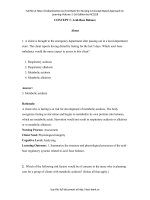Ancient philosophy a new history of western philosophy volume 1 (new history of western philosophy) ( PDFDrive ) 73
Bạn đang xem bản rút gọn của tài liệu. Xem và tải ngay bản đầy đủ của tài liệu tại đây (21.01 KB, 1 trang )
PYTHAGORAS TO PLATO
does not undergo any such change and is a quite diVerent thing. In the fourth
place we have knowledge, understanding, and true opinion on these matters—
these, collectively, are in our minds and not in sounds or bodily shapes, and thus
are clearly distinct from the circle itself and from the three entities already
mentioned. Of all these items, it is understanding that is closest to the Wfth in
kinship and likeness; the others are at a greater distance. What is true of round is
also true of straight, of colour, of good and beautiful, and just; of natural and
manufactured bodies; of Wre, water, and the other elements; of all living beings and
moral characters; of all that we do and undergo. In each case, anyone who totally
fails to grasp the Wrst four things will never fully possess knowledge of the
Wfth. (342a–d)
If I follow Plato, then, I will begin by distinguishing four things: the word
‘circle’, the deWnition of circle (a series of words), a diagram of a circle, and
my concept of a circle. The importance of being clear about these four
items is to distinguish them from, and contrast them with, a Wfth thing, the
most important of all, which he calls ‘the circle itself’. It is this that is one
of the Ideas of which Plato’s celebrated theory treats. The theory is a
wide-ranging one, as is clear from the sentence at the end of the paragraph
that lists the Welds in which the theory applies. In his other writings Plato
uses many other expressions to refer to Ideas. ‘Forms’ (eide) is probably the
most common, but the Idea or Form of X may be called ‘the X itself’, ‘that
very thing that is X’, or ‘Xness’, or ‘what X is’.
It is important to note what is absent from Plato’s list in the Seventh
Letter. He does not mention, even at the lowest level, actual material
circular objects such as cartwheels and barrels. The reason for his omission
is clear from other passages in his writings (e.g. Phd. 74a–c). The wheels and
barrel we meet in experience are never perfectly circular: somewhere or
other there will be a bend or bump which will interfere with the equidistance from the centre of every point on the circumference. This is true
too, for that matter, of any diagram we may draw on paper or in the sand.
Plato does not stress this point here, but it is the reason why he says that
the diagram is at a greater distance from the circle itself than my concept is.
My subjective concept of the circle—my understanding of what ‘circle’
means—is not the same as the Idea of the circle, because the Idea is an
objective reality that is not the property of any individual mind. But at least
the concept in my mind is a concept of a perfect circle; it is not merely an
imperfect approximation to a circle, as the ring on my Wnger is.
50









